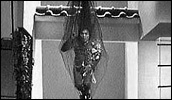Story of Sorrow and Sadness
- Year
- 1977
- Original title
- Hishu Monogatari
- Japanese title
- 悲愁物語
- Director
- Cast
- Running time
- 91 minutes
- Published
- 1 July 2003


by Jasper Sharp
Born in Tokyo, 24 May 1923, it's almost inevitable that Seijun Suzuki's arrival on the planet coincided with the year of the cataclysmic Kanto earthquake that laid waste to the nation's capitol and its surrounding area. Throughout his filmmaking career, Suzuki has had a similar predilection for rocking the boat. By the end of the 1960s, Suzuki's iconoclastic vision had also seen the director labelled as a troublemaker within Nikkatsu, the studios where he was working at the time, and after turning in the epitome of his off-beat approach with Branded to Kill in 1968, he was rather unceremoniously ousted from the company.
Glossed over in recent retrospectives of the director and seldom mentioned in discussions of his work, Suzuki's sole work of the 70s is actually one of the most peculiar entries in an oeuvre that is already marked out by its peculiarity - a sexy psycho-melodrama based around the popularity of that most bourgeois of sports, golf! "What's so interesting about a game where you hit a ball into a little hole?" asks one of the characters at an early point in the film. Well, watch and learn…
This particular tale of sorrow and sadness concerns professional model Reiko (Shiraki) groomed to the higher ranks of the golf circuit by the editor of a golfing fashion magazine in order to promote their latest range of sporting-wear. Her victory during her first professional competition ("The ball's gonna fly, wherever I will it to go!", she mutters to herself as she wipes the sweat from her furrowed brow) wins her not only the approval of her sideburned, shade-wearing mentor - with whom she immediately dives, newly won trophy in hand, straight beneath the shower after the match - but also with a whole new TV audience, where she makes regular appearances clad in a bikini and wielding a 9-iron. It seems that suddenly everyone wants a piece of Reiko, including neighbour-from-hell, Mrs Semba.
Semba-san's initial attempts to buy into Reiko's fame take the ostensible form of a telephoned complaint about the model's garage door. However, the curtain-twitching obsessive soon comes face to face with her idol when asking for autographs on a TV talk show. Things turn a little more sinister when this twisted celebrity stalker is knocked down in a drunken hit and run accident by Reiko and her manager. Persuading his protégée that reporting the incident may ruin her newfound fame, the couple leave the injured figure by the roadside.
That evening as Reiko practises her putts in the living room, she is confronted by the wounded Semba with a blackmail proposition. With her career seriously threatened, Reiko has no choice but to concur. However, the blackmailer is soon abusing her newly found power, sheering off Reiko's hair, and throwing drunken parties with her friends and neighbours in the model's house in which she lives with her adolescent younger brother (who resides up a rope ladder in his attic bedroom for much of the film). After a creepy lesbian kiss, Reiko finds herself succumbing more and more to Semba's violent fantasies.
Coming across like a deranged hybrid of Clint Eastwood's Play Misty for Me (1971) and Robert Aldrich's What Ever Happened to Baby Jane? (1962), this sinister social satire of Stepford Wives-esque suburban aspiration set against the glamorous world of big budget sports promotion is impossible to pigeonhole as anything other than a Suzuki film (Jo Shishido even crops up in a cameo).
Periodically interspersed with scenes of the younger brother's innocent flirtations beneath the cherry blossoms with an imaginary girl next door, and riddled with the director's wildly non-conformist use of non-contiguous edits, unhinged shot composition, and violent splashes of colour, crazed and chaotic and for too long buried in the sand bunkers of obscurity, this long-overlooked work simply cries out for revival - and thanks to this long overdue DVD release from the Hong Kong Platinum Classics label, it might finally even get the recognition it deserves.